Freeing Willie the Humpback Whale
An amazing Tristan rescue success from Conrad Glass |
||
| On Tuesday 29th November factory manager Erik McKenzie spotted a whale with a buoy and net caught around its tail about 200 metres off Calshot Harbour. Erik alerted Sean Burns who contacted Conrad Glass to assemble a Search and Rescue crew. Conrad was joined by Neil Swain, and Conrad's son Leon who left the harbour at 12.15 to investigate, carrying with them a boat hook and knife to attempt to free the whale. Sean Burns went along as photographer. | ||
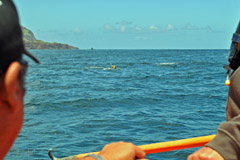 |
Photos from the RIB Left: approaching the stricken whale Right: Leon reaching out and cutting the netting around the buoy. |
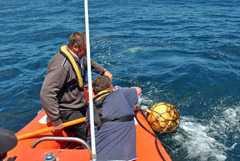 |
Conrad takes up the story:We were directed towards the whale by Eric from on top of the cliff via VHF radio. Sean kept radio contact; Leon stood by with knife in hand; while Neil stood in the bows holding on to the painter (bow rope) with one hand, the boat hook ready in the other. Suddenly Neil pointed with the boat hook and shouted "Thar she blows": 20 meters in front of the RIB, the whale surfaced, pulling a fishing buoy with a short stick attached. The buoy was about six metres behind the whale. I increased speed to catch the whale and steered the boat along side of it. The whale was a humpback, about eight meters long and about two meters wide. We made several approaches, trying to get as close as possible to identify the amount and type of fishing line - (were any hooks attached?) and gauge how close we could get to the whale, which was very stressed. Each time we approached, the whale would dive deeply, taking the buoy so far under the water with what appeared to be hardly any effort - indeed, going so deep that we could not see it. Both Neil and I were rather cautious in how we were going to attempt any rescue when we saw the size and actions of the whale. The whale would remain under for about five minutes before re-surfacing again. As soon as we approached, it would dive deeply again. "This is not giving us much time to hook onto the line and cut it" I said. "I don't see how we can cut the line if the whale keeps diving". Neil said: "Guys: we have to do something to help". Sean said the concern was apparent in his voice. Neil added: "If we can get the buoy cut off the rest of the line, it may work free itself". Leon pointed out: "It's the buoy that's keeping the line taut, as the whale swims or dives, the buoy keeps the tension on the line". I looked at Neil and Leon: "Right! lets do it; when the whale surfaces this time I will get close to it then let the RIB's momentum carry us close. Hopefully it will not force it to dive". We waited for a few moments: "There it is" said Leon, pointing to the whale that had just surfaced 10 metres on our port side. I quickly turned the RIB, cutting back to get behind the whale, then turning to allow the RIB to coast forward. Neil hooked onto the buoy with the boat hook, and quickly lifted it into the RIB with a mass of tangled line. "Now cut the line quickly" I said to Leon, who was standing on the port bow, but had to move to starboard bow to get at the fishing line. "Watch out for the fish hooks" Neil told Leon, as he frantically sawed at the line. First Leon cut the buoy loose, then Neil pulled another handful of tangled fishing line with a large hook attached and cut this. Neil said to Leon: " I think the single bit will come free" and "hold the line taut" Leon responded as Neil pulled more slack into the boat to be cut off. During this time I nudged the RIB closer behind the whale until we were about two meters from its tail. The strange thing is the whale seemed to sense that we were helping it, for the creature remained hardly moving. As Neil let go of the last bit of line, the whale dived deeply, swimming out to sea. Sean got some photos of this. Neil said that he could not see any other tangled line about its tail, so any single bits should work free. We identified the buoy, line and hook to be from a Japanese or Taiwanese long-line fishing vessel. Some of these lines are about sixty miles long. No doubt the whale got caught in one of the broken lines. These vessels fish illegally in the South Atlantic, We turned back to the harbour to clear immigration on the yacht Setna which had just arrived and had been told to keep clear of the whale while it had the buoy attached. I must add that the fishing line and buoy caught on the whale did not belong to Ovenstone Agency Ltd, the fishing company who have the contract to fish for crayfish in Tristan waters. Of all the rescues I have been asked to organise, freeing "Willie the Humpbacked Whale" rates the most unique by far! Conrad Glass MBE is the author of Rockhopper Copper which relates many real-life stories. Perhaps when the book goes into its third edition this 'Free Willie' story will be included? |
||
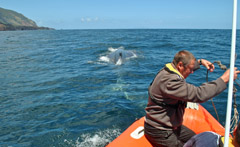 |
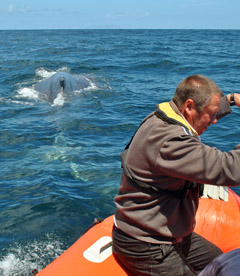 |
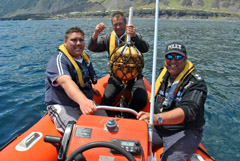 |
| Above and Centre: The freed whale swims away |
Above: The victorious crew of Leon, Neil and Conrad showing the 'ghost' gear abandoned by a poacher fishing crew that had ensnared the humpback whale | |
